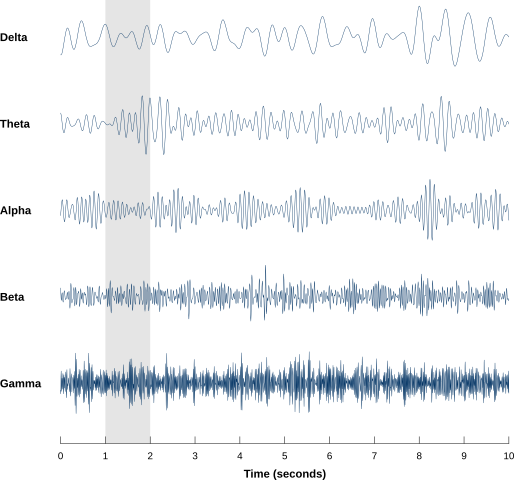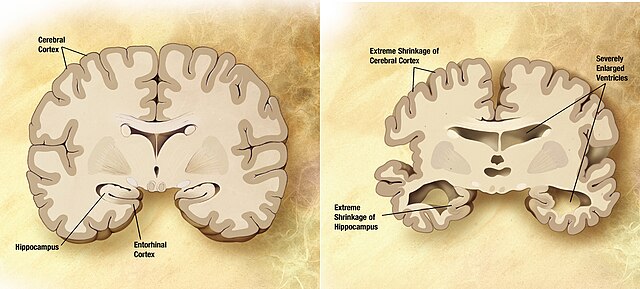Our daily lives are surrounded by various sounds. Among these, the power of specific frequencies has been gaining attention. The star of this show is the 40 Hz frequency. 40 Hz refers to a frequency that vibrates 40 times per second. While it might seem like just a number at first glance, recent scientific research has revealed that this frequency can have astonishing effects on the brain.
40 Hz falls within the range of gamma waves, a type of brain wave. Gamma waves are closely associated with higher brain functions and refer to frequency bands above 30Hz. Among these, 40 Hz has been drawing significant attention from neuroscientists for its potential to improve memory and cognitive functions, and even alleviate symptoms of Alzheimer’s disease.

Time-based waveform changes of the five main types of brain waves (Delta, Theta, Alpha, Beta, Gamma). The 40 Hz gamma wave is shown at the bottom, exhibiting the highest frequency and most complex waveform. The gray band in the center suggests stimulation or state change. This figure visually represents the changes in brain waves corresponding to different brain states and activities. By Laurens R. Krol
In recent years, research on the effects of 40 Hz on the brain has been rapidly progressing. Particularly, groundbreaking research results published by a team from the Massachusetts Institute of Technology (MIT) have caused a stir in the scientific community. This study showed that 40 Hz light and sound stimulation could potentially reduce the accumulation of amyloid-β protein in the brains of Alzheimer’s model mice and improve cognitive function.
This discovery has garnered great expectations not only as a subject of scientific interest but also as a potential new treatment for neurodegenerative diseases such as Alzheimer’s. Furthermore, as it may be applicable to enhancing the functions of healthy brains, 40 Hz has become a topic of interest for people across a wide age range.
In this article, we will explain in detail the effects of 40 Hz on the brain based on the latest scientific findings. We will also discuss how this frequency can be incorporated into daily life, along with methods and precautions. By understanding and implementing the potential of 40 Hz, we might open new paths for improving our brain health and function.
The Relationship Between 40 Hz and the Brain
The Role of Gamma Waves
To deepen our understanding of 40 Hz, we first need to know about gamma waves. Gamma waves belong to the highest frequency band of brain waves, typically referring to vibrations above 30Hz. These gamma waves are closely related to higher brain functions and are known to play important roles in cognitive functions such as memory, attention, and concentration.
When gamma waves are actively generated, neurons (nerve cells) in the brain synchronize their activity. This synchronized activity is thought to enhance information processing efficiency and promote communication between different brain regions. For example, an increase in gamma wave activity has been observed when learning new information or solving complex problems.
Particularly, 40 Hz gamma waves are believed to play a crucial role in memory formation and recall. Synchronized activity of gamma waves around 40 Hz has been observed between the hippocampus (the center of memory) and the cerebral cortex (the region responsible for higher cognitive functions), suggesting a close relationship with long-term memory formation.
Furthermore, gamma waves are involved in maintaining attention and concentration. To quickly respond to external information and focus on important information, different regions of the brain need to work in coordination. Gamma waves play a role in facilitating this coordinated work.
Scientific Research on 40 Hz Sound Waves and the Brain
In recent years, numerous studies have been conducted on the effects of 40 Hz sound waves on the brain. Particularly noteworthy is its relationship with Alzheimer’s disease.
In 2016, a research team from MIT published groundbreaking results in the journal “Nature”. This study showed that 40 Hz light stimulation to the visual cortex of mice reduced the accumulation of amyloid-β protein in the brain. Amyloid-β is considered one of the main causative substances of Alzheimer’s disease, and this discovery attracted significant attention.

Comparison of a healthy brain (left) and an Alzheimer’s disease brain (right). 40 Hz stimulation may potentially reduce the accumulation of amyloid-β.
Subsequent research revealed that similar effects could be obtained with 40 Hz sound wave stimulation. A study published in 2019 showed that exposing mice to 40 Hz sound waves for one hour activated neuronal activity in the hippocampus and improved cognitive function.
Interestingly, 40 Hz sound wave stimulation may also have positive effects on healthy brains. A 2018 study conducted experiments exposing healthy adults to 40 Hz sound waves. The results showed improvements in memory and attention test performances.
These research results suggest that 40 Hz sound waves may have the potential to enhance brain function by inducing gamma wave activity in the brain and promoting synchronized neuronal activity. It’s particularly noteworthy that this effect may be applicable not only to pathological conditions like Alzheimer’s disease but also to healthy brains.
However, many of these research results are still at the animal experiment stage, and further studies are needed to confirm the effects in humans. Additionally, there is still insufficient knowledge about the long-term effects of 40 Hz sound wave stimulation.
Practical Methods for Using 40 Hz
40 Hz as Music Therapy
One way to incorporate 40 Hz into daily life that has been gaining attention is music therapy. It is thought that listening to music or sounds containing the 40 Hz frequency might promote gamma wave activity in the brain.
The waveform of a 40 Hz sound wave. This frequency induces gamma waves. By Hugo Gambo – Own work, CC BY-SA 3.0, Link
Specific methods include:
- Binaural Beats: This method involves playing slightly different frequency sounds to each ear to induce brain waves at the difference frequency (in this case, 40 Hz). For example, playing a 440 Hz sound in the right ear and a 400 Hz sound in the left ear simultaneously generates a 40 Hz difference tone in the brain.
- Isochronic Tones: This method induces specific frequency brain waves by listening to sounds that play at regular intervals. For 40 Hz, the sound would play 40 times per second.
- 40 Hz Sound Sources: It’s also possible to listen to sound sources containing pure 40 Hz sound waves. However, considering that the lower limit of human audible range is about 20 Hz, 40 Hz sounds may be very low and difficult to hear. Therefore, sound sources containing higher harmonics are sometimes used.
These sound sources are often provided in professionally produced music or applications. For example, there are commercially available products such as meditation and relaxation music incorporating 40 Hz elements, or sound sources to aid sleep induction.
Incorporating 40 Hz into Daily Life

A person meditating while listening to a 40 Hz sound source. This is an example of incorporating 40 Hz into daily life.
There are several ways to incorporate 40 Hz into daily life:
- Meditation and Relaxation: You can use 40 Hz sound sources as background noise during meditation or relaxation time. For example, you might try incorporating it into your morning meditation or pre-sleep relaxation routine.
- Background Music for Work: Playing music with 40 Hz elements in the background during tasks that require concentration is another method. However, it’s important to keep the volume low enough not to interfere with your work.
- Exercise Music: Using 40 Hz sound sources during gentle exercises like yoga or stretching might help harmonize body and mind.
- Sleep Induction: Listening to 40 Hz sound sources at low volume for about 30 minutes before bedtime might help relax the brain and promote quality sleep.
- Using Specialized Devices: Specialized devices that provide both 40 Hz light and sound stimulation have been developed. Using these devices might provide more effective 40 Hz stimulation.
However, when incorporating 40 Hz, it’s important to adjust according to individual preferences and sensations. Some people might find certain sounds unpleasant, so it’s crucial to find a method that suits you.
Precautions
There are several precautions to keep in mind when using 40 Hz:
- Avoid excessive use, limiting it to about 30 minutes to an hour per day.
- Be mindful of the volume, especially when using headphones or earphones, to protect your hearing.
- There are individual differences, so if you don’t feel any effects, there’s no need to continue forcibly.
- If you have neurological issues such as epilepsy, consult a doctor before use.
- 40 Hz should be viewed as a complementary method, not a substitute for existing medical treatments or a healthy lifestyle.
- Avoid use while driving or operating dangerous machinery.
Conclusion
40 Hz may bring new possibilities for brain health and function enhancement. It has potential applications in the prevention and treatment of diseases like Alzheimer’s, as well as in activating healthy brains. However, research is still in its early stages, and there remain uncertainties about individual differences and long-term effects.
Let’s try incorporating 40 Hz into our lives to a reasonable extent, referring to scientific findings. Combining it with a healthy lifestyle may yield more promising results. It’s important to stay informed about ongoing research developments and wisely utilize new information as it becomes available.
Multi-sensory Gamma Stimulation Ameliorates Alzheimer's-Associated Pathology and Improves Cognition
Mechanisms of gamma oscillations
The role of gamma oscillations in central nervous system diseases: Mechanism and treatment


